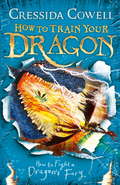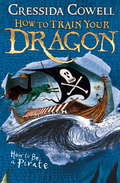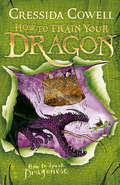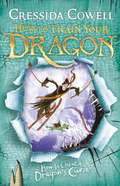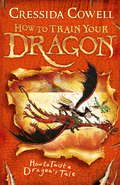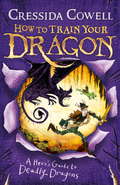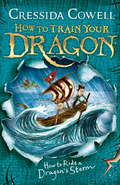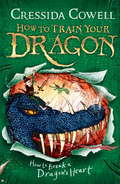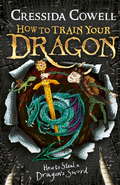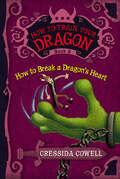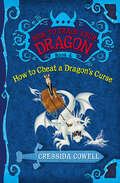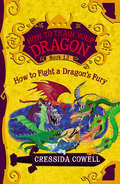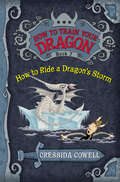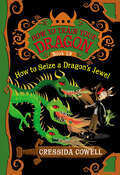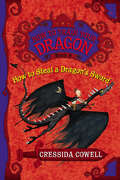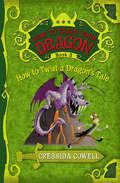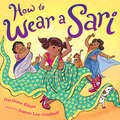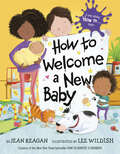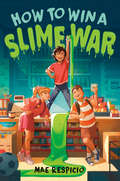- Table View
- List View
How to Train Your Dragon: Book 12 (How To Train Your Dragon Ser. #12)
by Cressida CowellRead the HILARIOUS books that inspired the HOW TO TRAIN YOUR DRAGON films! Hiccup Horrendous Haddock the Third is a smallish Viking with a longish name. Hiccup's father is chief of the Hairy Hooligan tribe which means Hiccup is the Hope and the Heir to the Hairy Hooligan throne - but most of the time Hiccup feels like a very ordinary boy, finding it hard to be a Hero. It is the Doomsday of Yule. At the end of this day, either the humans or the dragons will face extinction. Alvin the Treacherous is about to be crowned the King of the Wilderwest on the island of Tomorrow. His reign of terror will begin with the destruction of dragons everywhere.The fate of the dragon world lies in the hands of one young boy: Hiccup Horrendous Haddock the Third. If Hiccup can't beat Alvin the Treacherous then the entire human AND dragon race will become extinct. The time has come to prove himself, once and for all. Will Hiccup - with the help of his friends Fishlegs, Camicazi and Toothless the dragon - finally be crowned KING? And will the dragons survive?How to Train Your Dragon is now a major DreamWorks franchise starring Gerard Butler, Cate Blanchett and Jonah Hill and the TV series, Riders of Berk, can be seen on CBeebies and Cartoon Network.
How to Train Your Dragon: Book 2 (How To Train Your Dragon Ser. #2)
by Cressida CowellRead the HILARIOUS books that inspired the HOW TO TRAIN YOUR DRAGON films! Hiccup Horrendous Haddock the Third is a smallish Viking with a longish name. Hiccup's father is chief of the Hairy Hooligan tribe which means Hiccup is the Hope and the Heir to the Hairy Hooligan throne - but most of the time Hiccup feels like a very ordinary boy, finding it hard to be a Hero. When a huge, six-and-a-half-foot floating coffin with the words BEWARE! DO NOT OPEN THIS COFFIN arrives, can you guess what happens next?The Quest to discover the treasure of Hiccup's ancestors begins and Hiccup needs to find it before Alvin the Treacherous gets his hands on it. But when a dragon called the Monstrous Strangulator is thrown into the mix, things are about to get seriously SCARY.***Please note this ebook is TEXT ONLY and does not include the illustrations that appear in the printed book.***READ ALL 12 BOOKS IN THE SERIES!You don't have to read the books in order, but if you want to, this is the right order:1. How to Train Your Dragon2. How to Be a Pirate3. How to Speak Dragonese4. How to Cheat a Dragon's Curse 5. How to Twist a Dragon's Tale6. A Hero's Guide to Deadly Dragons7. How to Ride a Dragon's Storm8. How to Break a Dragon's Heart9. How to Steal a Dragon's Sword10. How to Seize a Dragon's Jewel11. How to Betray a Dragon's Hero12. How to Fight a Dragon's FuryHow to Train Your Dragon is now a major DreamWorks franchise starring Gerard Butler, Cate Blanchett and Jonah Hill and the TV series, Riders of Berk, can be seen on CBeebies and Cartoon Network.
How to Train Your Dragon: Book 2 (How to Train Your Dragon #2)
by Cressida CowellRead the HILARIOUS books that inspired the HOW TO TRAIN YOUR DRAGON films! Hiccup Horrendous Haddock the Third is a smallish Viking with a longish name. Hiccup's father is chief of the Hairy Hooligan tribe which means Hiccup is the Hope and the Heir to the Hairy Hooligan throne - but most of the time Hiccup feels like a very ordinary boy, finding it hard to be a Hero. When a huge, six-and-a-half-foot floating coffin with the words BEWARE! DO NOT OPEN THIS COFFIN arrives, can you guess what happens next?The Quest to discover the treasure of Hiccup's ancestors begins and Hiccup needs to find it before Alvin the Treacherous gets his hands on it. But when a dragon called the Monstrous Strangulator is thrown into the mix, things are about to get seriously SCARY.***Please note this ebook is TEXT ONLY and does not include the illustrations that appear in the printed book.***READ ALL 12 BOOKS IN THE SERIES!You don't have to read the books in order, but if you want to, this is the right order:1. How to Train Your Dragon2. How to Be a Pirate3. How to Speak Dragonese4. How to Cheat a Dragon's Curse 5. How to Twist a Dragon's Tale6. A Hero's Guide to Deadly Dragons7. How to Ride a Dragon's Storm8. How to Break a Dragon's Heart9. How to Steal a Dragon's Sword10. How to Seize a Dragon's Jewel11. How to Betray a Dragon's Hero12. How to Fight a Dragon's FuryHow to Train Your Dragon is now a major DreamWorks franchise starring Gerard Butler, Cate Blanchett and Jonah Hill and the TV series, Riders of Berk, can be seen on CBeebies and Cartoon Network.
How to Train Your Dragon: Book 3 (How To Train Your Dragon Ser. #3)
by Cressida CowellRead the HILARIOUS books that inspired the HOW TO TRAIN YOUR DRAGON films! Hiccup Horrendous Haddock the Third is a smallish Viking with a longish name. Hiccup's father is chief of the Hairy Hooligan tribe which means Hiccup is the Hope and the Heir to the Hairy Hooligan throne - but most of the time Hiccup feels like a very ordinary boy, finding it hard to be a Hero. When Hiccup's dragon Toothless is captured by Romans, only Hiccup and his friend Fishlegs can rescue him. But things get WORSE, when the Romans steal Hiccup's precious book HOW TO SPEAK DRAGONESE and Hiccup and Fishlegs are taken off to the Fortress of Sinister!Now they must save Toothless AND themselves - but how can they possibly escape? How to Train Your Dragon is now a major DreamWorks franchise starring Gerard Butler, Cate Blanchett and Jonah Hill and the TV series, Riders of Berk, can be seen on CBeebies and Cartoon Network.
How to Train Your Dragon: Book 3 (How to Train Your Dragon #3)
by Cressida CowellRead the HILARIOUS books that inspired the HOW TO TRAIN YOUR DRAGON films! Hiccup Horrendous Haddock the Third is a smallish Viking with a longish name. Hiccup's father is chief of the Hairy Hooligan tribe which means Hiccup is the Hope and the Heir to the Hairy Hooligan throne - but most of the time Hiccup feels like a very ordinary boy, finding it hard to be a Hero. When Hiccup's dragon Toothless is captured by Romans, only Hiccup and his friend Fishlegs can rescue him. But things get WORSE, when the Romans steal Hiccup's precious book HOW TO SPEAK DRAGONESE and Hiccup and Fishlegs are taken off to the Fortress of Sinister!Now they must save Toothless AND themselves - but how can they possibly escape? How to Train Your Dragon is now a major DreamWorks franchise starring Gerard Butler, Cate Blanchett and Jonah Hill and the TV series, Riders of Berk, can be seen on CBeebies and Cartoon Network.
How to Train Your Dragon: Book 4 (How To Train Your Dragon Ser. #4)
by Cressida CowellRead the HILARIOUS books that inspired the HOW TO TRAIN YOUR DRAGON films! Hiccup Horrendous Haddock the Third is a smallish Viking with a longish name. Hiccup's father is chief of the Hairy Hooligan tribe which means Hiccup is the Hope and the Heir to the Hairy Hooligan throne - but most of the time Hiccup feels like a very ordinary boy, finding it hard to be a Hero. Hiccup's best friend Fishlegs thinks he has a nasty cold, but Old Wrinkly has diagnosed . . . VORPENTITIS, caused by the sting of a Venomous Vorpent, which is pretty much ALWAYS FATAL!The only antidote is the Vegetable-that-No-one-Dares-Name - the POTATO. But the only way for Hiccup to find the cure is to face Norbert the Nutjob and the terrifying Sea Dragon, the DOOMFANG. Can Hiccup survive the quest to save his best friend - and discover how to cheat a dragon's curse?How to Train Your Dragon is now a major DreamWorks franchise starring Gerard Butler, Cate Blanchett and Jonah Hill and the TV series, Riders of Berk, can be seen on CBeebies and Cartoon Network.
How to Train Your Dragon: Book 5 (How To Train Your Dragon Ser. #5)
by Cressida CowellRead the HILARIOUS books that inspired the HOW TO TRAIN YOUR DRAGON films! Hiccup Horrendous Haddock the Third is a smallish Viking with a longish name. Hiccup's father is chief of the Hairy Hooligan tribe which means Hiccup is the Hope and the Heir to the Hairy Hooligan throne - but most of the time Hiccup feels like a very ordinary boy, finding it hard to be a Hero. Over on Lava-Lout Island, the volcano is ready to blow. Now Hiccup faces a terrifying Quest to Stop the Volcano Exploding, alongside his best friend Fishlegs and Humungously Hotshot the ex-Hero.But not only is Lava-Lout Island full of EXTERMINATOR DRAGONS, Hiccup's ARCH ENEMY is also lurking - and he's seeking REVENGE! How to Train Your Dragon is now a major DreamWorks franchise starring Gerard Butler, Cate Blanchett and Jonah Hill and the TV series, Riders of Berk, can be seen on CBeebies and Cartoon Network.
How to Train Your Dragon: Book 5 (How to Train Your Dragon #5)
by Cressida CowellRead the HILARIOUS books that inspired the HOW TO TRAIN YOUR DRAGON films! Hiccup Horrendous Haddock the Third is a smallish Viking with a longish name. Hiccup's father is chief of the Hairy Hooligan tribe which means Hiccup is the Hope and the Heir to the Hairy Hooligan throne - but most of the time Hiccup feels like a very ordinary boy, finding it hard to be a Hero. Over on Lava-Lout Island, the volcano is ready to blow. Now Hiccup faces a terrifying Quest to Stop the Volcano Exploding, alongside his best friend Fishlegs and Humungously Hotshot the ex-Hero.But not only is Lava-Lout Island full of EXTERMINATOR DRAGONS, Hiccup's ARCH ENEMY is also lurking - and he's seeking REVENGE! How to Train Your Dragon is now a major DreamWorks franchise starring Gerard Butler, Cate Blanchett and Jonah Hill and the TV series, Riders of Berk, can be seen on CBeebies and Cartoon Network.
How to Train Your Dragon: Book 6 (How To Train Your Dragon Ser. #6)
by Cressida CowellRead the HILARIOUS books that inspired the HOW TO TRAIN YOUR DRAGON films!Hiccup Horrendous Haddock the Third is a smallish Viking with a longish name. Hiccup's father is chief of the Hairy Hooligan tribe which means Hiccup is the Hope and the Heir to the Hairy Hooligan throne - but most of the time Hiccup feels like a very ordinary boy, finding it hard to be a Hero. Hiccup Haddock Horrendous the Third just wants a nice PEACEFUL birthday. But Hiccup's dad wants to steal the prized How to Train Your Dragon book, and prove that his Hooligans are just as good as the Bog Burglars - except Hiccup's dragon Toothless has EATEN it!So when Camicazi suggests stealing a copy from the grim Meathead Public Library, it seems like a good idea. BUT IT ISN'T! The library is guarded by the Horrible Hairy Scary the Librarian, four hundred Meathead Warrior Guards AND their Driller-Dragons . . . Will Hiccup survive - or is he DOOMED on his own birthday?ALSO INCLUDES A DRAGONESE DICTIONARY!How to Train Your Dragon is now a major DreamWorks franchise starring Gerard Butler, Cate Blanchett and Jonah Hill and the TV series, Riders of Berk, can be seen on CBeebies and Cartoon Network.
How to Train Your Dragon: Book 6 (How to Train Your Dragon #6)
by Cressida CowellRead the HILARIOUS books that inspired the HOW TO TRAIN YOUR DRAGON films!Hiccup Horrendous Haddock the Third is a smallish Viking with a longish name. Hiccup's father is chief of the Hairy Hooligan tribe which means Hiccup is the Hope and the Heir to the Hairy Hooligan throne - but most of the time Hiccup feels like a very ordinary boy, finding it hard to be a Hero. Hiccup Haddock Horrendous the Third just wants a nice PEACEFUL birthday. But Hiccup's dad wants to steal the prized How to Train Your Dragon book, and prove that his Hooligans are just as good as the Bog Burglars - except Hiccup's dragon Toothless has EATEN it!So when Camicazi suggests stealing a copy from the grim Meathead Public Library, it seems like a good idea. BUT IT ISN'T! The library is guarded by the Horrible Hairy Scary the Librarian, four hundred Meathead Warrior Guards AND their Driller-Dragons . . . Will Hiccup survive - or is he DOOMED on his own birthday?ALSO INCLUDES A DRAGONESE DICTIONARY!How to Train Your Dragon is now a major DreamWorks franchise starring Gerard Butler, Cate Blanchett and Jonah Hill and the TV series, Riders of Berk, can be seen on CBeebies and Cartoon Network.
How to Train Your Dragon: Book 7 (How To Train Your Dragon Ser. #7)
by Cressida CowellRead the HILARIOUS books that inspired the HOW TO TRAIN YOUR DRAGON films! Hiccup Horrendous Haddock the Third is a smallish Viking with a longish name. Hiccup's father is chief of the Hairy Hooligan tribe which means Hiccup is the Hope and the Heir to the Hairy Hooligan throne - but most of the time Hiccup feels like a very ordinary boy, finding it hard to be a Hero. Trapped on The American Dream II with his friends Fishlegs and Camicazi, Hiccup must ESCAPE the barbarian Norbert the Nutjob, and somehow dodge the cruel Polar-serpents in the icy waters below. If ONLY Hiccup hadn't promised to help the Wanderer slaves on board escape too! HOW will Hiccup save himself, his friends and a hundred and twenty-two Wanderers off a ship WITHOUT their terrifying captors noticing?How to Train Your Dragon is now a major DreamWorks franchise starring Gerard Butler, Cate Blanchett and Jonah Hill and the TV series, Riders of Berk, can be seen on CBeebies and Cartoon Network.
How to Train Your Dragon: Book 7 (How to Train Your Dragon #7)
by Cressida CowellRead the HILARIOUS books that inspired the HOW TO TRAIN YOUR DRAGON films! Hiccup Horrendous Haddock the Third is a smallish Viking with a longish name. Hiccup's father is chief of the Hairy Hooligan tribe which means Hiccup is the Hope and the Heir to the Hairy Hooligan throne - but most of the time Hiccup feels like a very ordinary boy, finding it hard to be a Hero. Trapped on The American Dream II with his friends Fishlegs and Camicazi, Hiccup must ESCAPE the barbarian Norbert the Nutjob, and somehow dodge the cruel Polar-serpents in the icy waters below. If ONLY Hiccup hadn't promised to help the Wanderer slaves on board escape too! HOW will Hiccup save himself, his friends and a hundred and twenty-two Wanderers off a ship WITHOUT their terrifying captors noticing?How to Train Your Dragon is now a major DreamWorks franchise starring Gerard Butler, Cate Blanchett and Jonah Hill and the TV series, Riders of Berk, can be seen on CBeebies and Cartoon Network.
How to Train Your Dragon: Book 8 (How To Train Your Dragon Ser. #8)
by Cressida CowellRead the HILARIOUS books that inspired the HOW TO TRAIN YOUR DRAGON films! Hiccup Horrendous Haddock the Third is a smallish Viking with a longish name. Hiccup's father is chief of the Hairy Hooligan tribe which means Hiccup is the Hope and the Heir to the Hairy Hooligan throne - but most of the time Hiccup feels like a very ordinary boy, finding it hard to be a Hero. Whilst searching for his lost friend Camicazi, Hiccup and the Hooligan Tribe have ended up on Uglithug Island. Now UG, the most brutal King in the World, sets Hiccup the Impossible Task. He must venture to the Isle of Berserk to pass his test or DIE trying. And all while being hunted down by an old enemy with a dark secret about the Lost Throne... Can Hiccup find Camicazi, and succeed in his task?How to Train Your Dragon is now a major DreamWorks franchise starring Gerard Butler, Cate Blanchett and Jonah Hill and the TV series, Riders of Berk, can be seen on CBeebies and Cartoon Network.
How to Train Your Dragon: Book 8 (How to Train Your Dragon #8)
by Cressida CowellRead the HILARIOUS books that inspired the HOW TO TRAIN YOUR DRAGON films! Hiccup Horrendous Haddock the Third is a smallish Viking with a longish name. Hiccup's father is chief of the Hairy Hooligan tribe which means Hiccup is the Hope and the Heir to the Hairy Hooligan throne - but most of the time Hiccup feels like a very ordinary boy, finding it hard to be a Hero. Whilst searching for his lost friend Camicazi, Hiccup and the Hooligan Tribe have ended up on Uglithug Island. Now UG, the most brutal King in the World, sets Hiccup the Impossible Task. He must venture to the Isle of Berserk to pass his test or DIE trying. And all while being hunted down by an old enemy with a dark secret about the Lost Throne... Can Hiccup find Camicazi, and succeed in his task?How to Train Your Dragon is now a major DreamWorks franchise starring Gerard Butler, Cate Blanchett and Jonah Hill and the TV series, Riders of Berk, can be seen on CBeebies and Cartoon Network.
How to Train Your Dragon: Book 9 (How To Train Your Dragon Ser. #9)
by Cressida CowellRead the HILARIOUS books that inspired the HOW TO TRAIN YOUR DRAGON films! Hiccup Horrendous Haddock the Third is a smallish Viking with a longish name. Hiccup's father is chief of the Hairy Hooligan tribe which means Hiccup is the Hope and the Heir to the Hairy Hooligan throne - but most of the time Hiccup feels like a very ordinary boy, finding it hard to be a Hero. Bad times have come to the Archipelago. Ever since the woods of Berserk burned down, it is almost as if the world is cursed. Dragons are starting to revolt against their Masters. The waters have risen, flooding fields and washing whole villages away. But worse still, the wicked witch Excellinor has returned. Can Hiccup find the King's Things and win the sword-fighting contest to stop Alvin the Treacherous from becoming King of the Wilderwest?***Please note this ebook is TEXT ONLY and does not include the illustrations that appear in the printed book.***READ ALL 12 BOOKS IN THE SERIES!You don't have to read the books in order, but if you want to, this is the right order:1. How to Train Your Dragon2. How to Be a Pirate3. How to Speak Dragonese4. How to Cheat a Dragon's Curse 5. How to Twist a Dragon's Tale6. A Hero's Guide to Deadly Dragons7. How to Ride a Dragon's Storm8. How to Break a Dragon's Heart9. How to Steal a Dragon's Sword10. How to Seize a Dragon's Jewel11. How to Betray a Dragon's Hero12. How to Fight a Dragon's FuryHow to Train Your Dragon is now a major DreamWorks franchise starring Gerard Butler, Cate Blanchett and Jonah Hill and the TV series, Riders of Berk, can be seen on CBeebies and Cartoon Network.
How to Train Your Dragon: How to Break a Dragon's Heart
by Cressida CowellStranded on the exceptionally dangerous, and possibly haunted, Beach of the Broken Heart, Hiccup must face Ug the Uglithug and complete the Impossible Task--or die trying. Along the way, he'll have to battle Berserks, dodge Scarers, and save Fishlegs from being fed to the Beast, all while being hunted down by an old enemy with a dark secret about the mysterious Lost Throne. With Toothless by his side, and time to stage his rescue running out, what's a Hero to do?
How to Train Your Dragon: How to Cheat a Dragon's Curse
by Cressida CowellIn his 4th sidesplitting adventure, Hiccup Horrendous Haddock III must rescue his best friend, Fishlegs, from the deadly disease Vorpentitis. The only cure is rare and almost impossible to find...a potato. But where will Hiccup find such a thing? He'll have to dodge the terrible Sharkworms, battle Doomfangs, and outwit crazy Hooligans if he's going to be a Hero...again.A fast paced plot, slapstick humor, witty dialogue and imaginative black and white illustrations enhance this exciting tale.
How to Train Your Dragon: How to Fight a Dragon's Fury
by Cressida CowellBook 12 is the epic finale to the New York Times bestselling How to Train Your Dragon series! The Doomsday of Yule has arrived, and the future of dragonkind lies in the hands of one boy with nothing to show, but everything to fight for. Hiccup's quest is clear... But can he end the rebellion? Can he prove himself to be king? Can he save the dragons? The stakes have never been higher, as the very fate of the Viking world hangs in the balance!
How to Train Your Dragon: How to Ride a Dragon's Storm
by Cressida CowellHiccup Horrendous Haddock III, everyone's favorite reluctant Viking hero, has three months, five days and six hours to discover America, get back to Berk, save his father, battle Polarserpents and win the annual Inter-Tribal Friendly Swimming Race. Can he do it?
How to Train Your Dragon: How to Seize a Dragon's Jewel
by Cressida CowellThe Dragon Rebellion has begun, bringing the Vikings' darkest hour upon them. Hiccup has become an outcast, but that won't stop him from going on the most harrowing and important quest of his life. He must find the Dragon's Jewel in order to save his people...but where should he begin? Don't miss Hiccup's most dangerous adventure yet!
How to Train Your Dragon: How to Steal a Dragon's Sword
by Cressida CowellThe How to Train Your Dragon series chronicles the adventures and misadventures of Viking underdog Hiccup Horrendous Haddock III and his dragon, Toothless. In Book 9, a dragon rebellion is coming--filled with the meanest, nastiest dragons in the Archipelago. Razor-wings, Tonguetwisters, and Vampire Ghouldeaths are attacking Vikings and seem to be seeking one soul in particular: Hiccup Horrendous Haddock the Third! Only a King can save them...and only a champion with all of the King's Lost Things can be King. In his adventures, Hiccup has collected quite a few "things" himself. But can a scrawny Viking save the entire Archipelago from certain doom? To find out, Hiccup will have to outwit a witch, fight his arch-enemy, and beat back an army of bloodthirsty dragons with just one sword.
How to Train Your Dragon: How to Twist a Dragon's Tale
by Cressida CowellSomeone has stolen the Fire Stone. Now the volcano on Volcano Island has become active and the tremors are hatching the eggs of the Exterminator dragons. Can Viking hero Hiccup return the Fire Stone in time to save the Tribes from being wiped out by the Exterminators? Illustrations.
How to Wear a Sari
by Darshana KhianiSparkling with voice and charm, this picture book about a fashionable kid out to prove she&’s not as small as everyone thinks is perfect for kids eager to grow up, and for those who love to play dress-up.Being a little kid isn&’t always fun and games. Sometimes, it&’s downright annoying. When a little girl tires of being treated like she&’s TOO little, she sets out to prove to her family that she can do ANYTHING she puts her mind to . . . . . . including putting on a colorful, twinkly, silky sari. Sure, they&’re long and unwieldy—but that only means her family will be even more impressed when she puts it on all by herself. Naturally, there are some hiccups along the way, but she discovers that she&’s not the only one in her family who has set out with something to prove, with hilariously chaotic results. That&’s what photo albums are for!
How to Welcome a New Baby (How To Series)
by Jean ReaganFrom the New York Times bestselling creators of How to Babysit a Grandma and How to Babysit a Grandpa comes a fun and adorable picture book about how to welcome a new baby into your family!A new baby is coming! Do you know what to do? This heartwarming new addition to the bestselling How to... series is all about welcoming a new sibling into your family. Learn how to get ready for the baby, how to make the baby laugh, and how to help Mom and Dad when things get a little topsy-turvy. Follow along through the first year of baby's life, and learn How To... from the experts -- kids! Filled with charming role-reversal humor, creative ideas, and sweet moments, How To Welcome a New Baby is sure to delight new siblings and growing families everywhere!
How to Win a Slime War
by Mae RespicioTwo kids face off in an epic battle to see who can sell the most slime, while navigating sticky situations with friends and family. <p><p> Alex Manalo and his dad have just moved back to Sacramento to help out with their extended family's struggling Filipino market. While Alex likes helping in the store, his true passion is making slime! He comes up with his own recipes and plays with ingredients, colors, and different bumpy or sparkly bits, which make his slime truly special. A new friend encourages Alex to sell his creations at school, which leads to a sell-off battle with a girl who previously had a slime-opoly. Winner gets bragging rights and the right to be the only slime game in town. <p><p> But Alex's dad thinks Alex should be focused more on "traditional" boy pastimes and less on slime. As the new soccer coach, Dad gets Alex to join the team. Even though he hates sports, Alex gives in. Alex is battling on multiple fronts--with his new friends at school, and with his dad at home. It will be a sticky race to the finish to see who oozes out on top.
